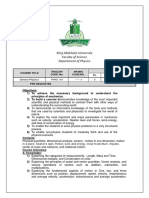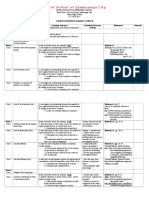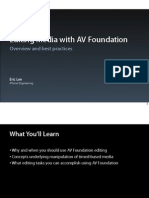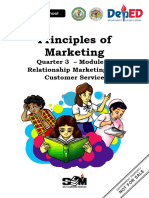Ap 1 Syllabus Updated 2015
Ap 1 Syllabus Updated 2015
Uploaded by
api-241278765Copyright:
Available Formats
Ap 1 Syllabus Updated 2015
Ap 1 Syllabus Updated 2015
Uploaded by
api-241278765Original Title
Copyright
Available Formats
Share this document
Did you find this document useful?
Is this content inappropriate?
Copyright:
Available Formats
Ap 1 Syllabus Updated 2015
Ap 1 Syllabus Updated 2015
Uploaded by
api-241278765Copyright:
Available Formats
Citron AP Physics 1 Syllabus
1066434v2
Course Introduction
AP
Physics
1
is
an
algebra-based
course
in
general
physics
that
meets
for
50
minutes
each
day
for
the
en<re
school
year.
General
physics
topics
presented
during
the
course
closely
follow
those
outlined
by
the
College
Board
and
also
mirrors
an
introductory
level
university
physics
course.
AP
Physics
1
is
organized
around
six
big
ideas
that
bring
together
the
fundamental
science
principles
and
theories
of
general
physics.
These
big
ideas
are
intended
to
encourage
students
to
think
about
physics
concepts
as
interconnected
pieces
of
a
puzzle.
The
solu<on
to
the
puzzle
is
how
the
real
world
around
them
actually
works.
The
students
will
par<cipate
in
inquiry-based
explora<ons
of
these
topics
to
gain
a
more
conceptual
understanding
of
these
physics
concepts.
Students
will
spend
less
of
their
<me
in
tradi<onal
formula-based
learning
and
more
of
their
eort
will
be
directed
to
developing
cri<cal
thinking
and
reasoning
skills.
Textbook
Serway,
R.
(2006).
College
physics
(7th
ed.).
Pacic
Grove,
CA:
Thomson-Brooks/Cole.
Materials
Lab Notebook (Composition book) - No spiral, No Tear out
Calculator (Scientific pref)
3 Three-Ring Binder w/ note-taking paper
CR1 Students and teachers have access to college-level resources including
college-level textbooks and reference materials in print or electronic format.
Big Ideas for AP Physics 1
Big Idea 1: Objects and systems have properties such as mass and charge. Systems may have internal
structure.
Big Idea 2: Fields existing in space can be used to explain interactions.
Big Idea 3: The interactions of an object with other objects can be described by forces.
Big Idea 4: Interactions between systems can result in changes in those systems.
Big Idea 5: Changes that occur as a result of interactions are constrained by conservation laws.
Big Idea 6: Waves can transfer energy and momentum from one location to another without the
permanent transfer of mass and serve as a mathematical model for the description of other phenomena.
The big ideas for AP Physics 1 are correlated to the content of the course and to the lab and inquirybased investigations done throughout the school year in the following table.
Citron AP Physics 1 Syllabus
1066434v2
Outline of AP Physics 1 Principles and Correlation to Big Ideas (BI):
Physics Principles
BI 1 BI 2 BI 3 BI 4 BI 5 BI 6
Kinema?cs
[CR2a]
Chap 1: Vectors and Mathematical Concepts
Chap 2: One Dimensional Kinematics
Chap 3: Two Dimensional Motion and Projectile
Motion
Dynamics of Force and Motion [CR2b]
Chap 4: Newtons Laws of Motion
Chap 5: Circular Motion, Rotation, and Gravity
Chap 4: Newtons Laws of Motion
Chap 5: Circular Motion, Rotation, and Gravity
Simple Pendulum and Mass-Spring
Systems
[CR2d]Laws of Motion
Chap 4: Newtons
Chap 10: Oscillations & Simple Harmonic Motion
Impulse, Linear Momentum,and Conserva?on
of Linear
Momentum
[CR2e]and Collisions
Chap
7: Impulse,
Momentum,
Chap 6: Work, Energy, and Power
Rotational Kinema?cs and Conserva?on
of
Angular
Momentum
[CR2g]
Chap
8: Rotational
Kinematics
& Rotational Energy
Chap 9: Torque & Rotational Dynamics
Universal Law of Gravitation [CR2c]
X
X
Work, Energy, and Conserva?on of Energy [CR2f]
Electrostatics
[CR2h]
Chap 18: Conservation of Electric Charge, Electric
Forces & Fields
Chap 19: Electrostatics; Conductors, Capacitors
Simple DC Circuits [CR2i]
Chap 20: Electric circuits, Ohms law, Kirchhoffs
laws
Waves and Sound
Chap 16: Mechanical Waves and Sound [CR2j]
Chap 17: The Principle of Linear Superposition and
Interference Phenomena
Citron AP Physics 1 Syllabus
1066434v2
CR2a The course design provides opportunities for
students to develop understanding of the foundational
principles of kinematics in the context of the big ideas
that organize the curriculum framework.
CR2e The course design provides opportunities for
students to develop understanding of the foundational
principles of linear momentum in the context of the big
ideas that organize the curriculum framework.
CR2b The course design provides opportunities for
students to develop understanding of the foundational
principles of dynamics in the context of the big ideas that
organize the curriculum framework.
CR2f The course design provides opportunities for
students to develop understanding of the foundational
principle of energy in the context of the big ideas that
organize the curriculum framework.
CR2c The course design provides opportunities for
students to develop understanding of the foundational
principles of gravitation and circular motion in the
context of the big ideas that organize the curriculum
framework.
CR2g The course design provides opportunities for
students to develop understanding of the foundational
principles of rotational motion in the context of the big
ideas that organize the curriculum framework.
CR2d The course design provides opportunities for
students to develop understanding of the foundational
principles of simple harmonic motion in the context of the
big ideas that organize the curriculum framework.
CR2h The course design provides opportunities for
students to develop understanding of the foundational
principles of electrostatics in the context of the big ideas
that organize the curriculum framework.
CR2i The course design provides opportunities for
students to develop understanding of the foundational
principles of electric circuits in the context of the big
ideas that organize the curriculum framework.
CR2j The course design provides opportunities for
students to develop understanding of the foundational
principles of mechanical waves in the context of the big
ideas that organize the curriculum framework.
Outline of AP Physics 1 Labs and investigations with Correlation to Big Ideas (BI):
Physics Principles and APScience
Prac?ces [CR6a] [CR6b]
BI 1 BI 2 BI 3 BI 4 BI 5 BI 6
Kinema?cs
1. Car Velocity Lab: students determine the
velocity and acceleration of a toy car.
1.4, 2.1, 2.2, 3.3, 4.1, 5.1, 6.2
2. Reaction Time: students figure out a method to
determine their reaction time.
Guided-Inquiry Investigation
1.4, 2.1, 2.2, 3.1, 4.2, 5.1, 6.1, 6.2, 7.2
3. Projectile Motion 1: students determine the
landing location of a ball launched horizontally
from a table.
1.1, 1.4, 2.1, 2.2, 3.3, 5.1, 6.1
4. Projectile Motion 2: students have to shoot
a ball through a hoop placed at a particular
location when launched at an angle.
1.1, 1.4, 2.1, 2.2, 3.3, 5.1, 6.1
Dynamics of Force and Motion
5. Force Table and Vectors: students determine
missing forces to produce translational
equilibrium.
1.4,2.1,2.2, 3.3, 5.1, 5.2, 6.2
6. Atwoods Machine: students determine the
formula for the acceleration of a simple
Atwoods machine.
1.4, 2.1, 2.2, 3.3, 5.1, 5.2, 6.2
Citron AP Physics 1 Syllabus
1066434v2
7. Inclined Planes Forces and Friction: students
determine what effect an incline has on the
value of friction and determine coefficients of
friction for various objects.
Guided-Inquiry Investigation
1.4, 2.1, 2.2, 3.1, 4.2, 5.1, 5.2, 6.1, 7.2
Universal Law of Gravitation
8. Galileo Ramps: students use ramps at different
angles to determine what happens to the
acceleration.
1.1, 1.4, 2.1, 2.2, 3.2, 4.1, 5.1, 5.2, 6.2, 7.2
9. Kepler Exoplanet Data: students determine
Keplers laws by analyzing actual data.
Inquiry Investigation
1.4, 2.1, 2.2, 3.1, 4.1, 4.2, 4.3, 5.1, 6.2, 6.3, 7.2
Simple Pendulum and Mass-Spring Systems
10. Hookes Law: students determine the
relationship between distance stretched and
force.
1.1, 1.4, 2.1, 2.2, 3.3, 4.1, 5.1, 6.2, 7.2
11. Pendulum Properties: students determine what
factors affect the period of a pendulum
Guided-Inquiry Investigation
1.1, 2.1, 2.2, 3.1, 4.1, 4.2, 5.1, 5.2, 6.1, 6.2, 7.2
Impulse, Momentum, and Conserva?on of
Momentum
12. Momentum and Collisions: students determine
momentum before and after in different types
of collisions.
1.1, 1.4, 2.1, 2.2, 3.3, 4.1, 5.1, 6.2
13. Car Crash Physics: students design a car that
will safely protect an egg in a crash.
Open-Inquiry Investigation
1.1, 1.4, 2.1, 2.2, 3.1, 3.3, 4.1, 4.2, 5.1, 5.2,
6.1, 6.2, 7.2
14. Ballistics Pendulum: students determine the
initial speed of a bullet.
Guided-Inquiry Investigation
1.1, 1.4, 2.1, 2.2, 3.1, 3.2, 4.1, 4.2, 5.1, 5.2,
6.1, 6.2, 7.2
15. Energy to Work Lab: students determine how
work changes energy.
1.1, 1.4, 2.1, 2.2, 3.3, 4.1, 5.1, 6.2
Work, Energy, and Conserva?on of Energy
Citron AP Physics 1 Syllabus
1066434v2
Rotational Kinema?cs and Conserva?on of
Angular Momentum
16. Torque Lab: students determine factors that
affect the rotational motion of an object.
1.1, 1.4, 2.1, 2.2, 3.3, 4.1, 5.1, 6.2
17. Rolling Cylinders: students determine how the
type of cylinder rolled affects time of roll.
1.1, 1.4, 2.1, 2.2, 3.3, 4.1, 5.1, 6.2
18. Flying Pigs and Centripetal Force: students
determine the factors that affect centripetal
force.
Guided-Inquiry Investigation
1.1, 1.4, 2.1, 2.2, 3.1, 4.1, 4.2, 5.1, 5.2, 6.1,
6.2, 7.2
Electrostatics
19. Coulombs Law: students determine the
relationship between force, charge and
distance between charges.
Guided-Inquiry Investigation
1.1, 1.4, 2.1, 2.2, 3.1, 4.1, 4.2, 5.1, 5.2, 6.1,
6.2, 7.2
Simple
DC
Circuits
20. Electric Circuit Lab: students determine voltage
and current relationships in simple circuit
orientations (series and parallel).
Open-Inquiry Investigation
1.1, 1.4, 2.1, 2.2, 3.1, 4.1, 4.2, 5.1, 5.2, 6.1,
6.2, 7.2
Waves and Sound
21. Resonance Apparatus Lab: students determine
the speed of sound by using resonance in a
tube.
Guided-Inquiry Investigation
1.1, 1.4, 2.1, 2.2, 3.1, 4.1, 4.2, 5.1, 5.2, 6.1,
6.2, 7.2
22. Beats and Standing Waves: students determine
how beats and standing waves are produced.
1.1, 1.4, 2.1, 2.2, 3.3, 4.1, 5.1, 6.2
CR6a The laboratory work used throughout the course
includes investigations that support the foundational AP
Physics 1 principles.
CR6b The laboratory work used throughout the course
includes guided-inquiry laboratory investigations allowing
students to apply all seven science practices.
Citron AP Physics 1 Syllabus
1066434v2
Additional Course Information
Labs & Classwork
Labs are all hands-on and placed throughout the instructional year.
Students will spend at least 25% of class time in laboratory investigations. [CR5]
Labs can be either teacher directed or student directed/open-ended.
During a teacher-directed lab , the students are given instruction on the operation of lab equipment and
guidance in the process of the experiment.
Student-directed labs are when the students are given an objective, e.g.Determine the acceleration due
to gravity on Earth, and standard materials needed to conduct a lab.
Time after AP Test will be spent on Relativity, Astronomy, and other topics.
Students are allowed to create their own experimental design and collect data, which can be analyzed
through graphical methods. These inquiry-based investigations or student-directed labs have an extra
element added to the lab report. After these labs, each student group must present their results to the
class and defend their results. They will also evaluate one other group's approach to the problem and
offer a critique of their procedures and results. [CR8]
Students work in lab groups, but each student must submit a lab report which is turned in the day after
the conclusion of each activity, then graded and returned. The report must include the following
components: [CR7]
Statement of the problem
Hypothesis
Discussion or outline of how the procedure will be carried out
Data collected from the experiment
Data analysis
Conclusion including error analysis
Peer review (if included in this lab)
Students are required to keep the reports in an organized lab notebook. This lab notebook will kept by
the students for the entire year and must include the completed lab reports as well as the raw data
tables and any notes made during the execution of the labs done in the course. [CR7]
Two lab investigations during the year are extended projects that require using data collected by
outside sources. Students will utilize this data to find out answers to questions posed by the instructor
and also questions they formulate themselves.
Citron AP Physics 1 Syllabus
1066434v2
Real World Activity Examples
Car Crash Physics
This past year a lawyer approached me with a problem. His client was hurt in a crash, but the insurance company was
claiming there was not enough force generated in the crash to cause injuries. The students will be given the same
problem and asked to come up with an answer to the insurance company. They will research information needed and
write a report detailing their conclusions. Each group will present their findings to the class and also review and
critique another groups conclusions and methods used to come up with their answer. As one group presents their
findings as experts, the other group will be acting as the insurance company trying to find holes in their argument.
[CR4]
Kepler Telescope Exoplanet Discovery
The Kepler telescope has been discovering evidence about new planets around other stars for the last few years.
Some of this data is posted on the Internet and we will use it to determine properties of these planets.Students will
have a new planet to investigate and determine as many physical properties about that planet as possible form the
data set. The investigation requires the students to utilize Learning Objectives 2.B.2.1, 3.A.2.1, 3.A.4.2, 3.B.2.1, 3.C.
1.2, and 4.A.1.1. [CR3]
CR3 Students have opportunities to apply AP Physics 1
learning objectives connecting across enduring
understandings as described in the curriculum
framework. These opportunities must occur in addition
to those within laboratory investigations.
CR4 The course provides students with opportunities to
apply their knowledge of physics principles to real world
questions or scenarios (including societal issues or
technological innovations) to help them become
scientifically literate citizens.
CR5 Students are provided with the opportunity to spend a
minimum of 25 percent of instructional time engaging in
hands-on laboratory work with an emphasis on inquiry-based
investigations.
CR7 The course provides opportunities for students to
develop their communication skills by
recording evidence of their research of literature or scientific
investigations through verbal, written, and graphic
presentations.
CR8 The course provides opportunities for students to
develop written and oral scientific argumentation skills.
For more information on the following, please reference the student handbook page numbers
-attendance p.15
-excessive absences p.16
-controversial curriculum p.56
Citron AP Physics 1 Syllabus
1066434v2
Curricular Requirements
CR1
Students and teachers have access to college-level resources including college-level textbooks and
reference materials in print or electronic format.
Pag
s)
1
CR2a
The course design provides opportunities for students to develop understanding of the foundational
principles of kinematics in the context of the big ideas that organize the curriculum framework.
CR2b
The course design provides opportunities for students to develop understanding of the foundational
principles of dynamics in the context of the big ideas that organize the curriculum framework.
CR2c
The course design provides opportunities for students to develop understanding of the foundational
principles of gravitation and circular motion in the context of the big ideas that organize the curriculum
framework.
CR2d
The course design provides opportunities for students to develop understanding of the foundational
principles of simple harmonic motion in the context of the big ideas that organize the curriculum
framework.
CR2e
The course design provides opportunities for students to develop understanding of the foundational
principles of linear momentum in the context of the big ideas that organize the curriculum framework.
CR2f
The course design provides opportunities for students to develop understanding of the foundational
principle of energy in the context of the big ideas that organize the curriculum framework.
CR2g
The course design provides opportunities for students to develop understanding of the foundational
principles of rotational motion in the context of the big ideas that organize the curriculum framework.
CR2h
The course design provides opportunities for students to develop understanding of the foundational
principles of electrostatics in the context of the big ideas that organize the curriculum framework.
CR2i
The course design provides opportunities for students to develop understanding of the foundational
principles of electric circuits in the context of the big ideas that organize the curriculum framework.
CR2j
The course design provides opportunities for students to develop understanding of the foundational
principles of mechanical waves in the context of the big ideas that organize the curriculum framework.
CR3
Students have opportunities to apply AP Physics 1 learning objectives connecting across enduring
understandings as described in the curriculum framework. These opportunities must occur in addition to
those within laboratory investigations.
CR4
The course provides students with opportunities to apply their knowledge of physics principles to real world
questions or scenarios (including societal issues or technological innovations) to help them become
scientifically literate citizens.
CR5
Students are provided with the opportunity to spend a minimum of 25 percent of instructional time
engaging in hands-on laboratory work with an emphasis on inquiry-based investigations.
CR6a
The laboratory work used throughout the course includes investigations that support the foundational AP
Physics 1 principles.
CR6b
The laboratory work used throughout the course includes guided-inquiry laboratory investigations
allowing students to apply all seven science practices.
CR7
The course provides opportunities for students to develop their communication skills by recording evidence
of their research of literature or scientific investigations through verbal, written, and graphic
presentations.
CR8
The course provides opportunities for students to develop written and oral scientific argumentation skills.
You might also like
- 1.stripe Cashout MethodDocument1 page1.stripe Cashout Methodhoang tuan linh50% (2)
- PHY 1101 Physics1 - Course Outline (Spring 2023-2024)Document9 pagesPHY 1101 Physics1 - Course Outline (Spring 2023-2024)faisalfahim228No ratings yet
- CMOS Digital Integrated CircuitsDocument405 pagesCMOS Digital Integrated CircuitsAmr Yassin100% (1)
- AP Physics 1 Gilmour Academy 2019-2020: E Block (Wednesday)Document8 pagesAP Physics 1 Gilmour Academy 2019-2020: E Block (Wednesday)pepsiloverNo ratings yet
- AP Physics 1 Sample Syllabus 4Document8 pagesAP Physics 1 Sample Syllabus 4api-269229107No ratings yet
- توصيف مقررات الفيزياء الطبيةDocument68 pagesتوصيف مقررات الفيزياء الطبيةشهد بنت علي رديفNo ratings yet
- AP Physics 1 Syllabus 2022Document10 pagesAP Physics 1 Syllabus 2022SarbajitMannaNo ratings yet
- Condensed Couse OutlinesDocument7 pagesCondensed Couse OutlinesnaolmenderaNo ratings yet
- General Physics SylabusDocument5 pagesGeneral Physics SylabusTadesse AbateNo ratings yet
- Common Pool of Generic Electives (Ge) Courses: Category-IVDocument3 pagesCommon Pool of Generic Electives (Ge) Courses: Category-IVvalacfosaleNo ratings yet
- Physics DeptDocument5 pagesPhysics Deptsharmaanjy06No ratings yet
- Teacher Toolkit - Satellite Motion: ObjectivesDocument2 pagesTeacher Toolkit - Satellite Motion: ObjectivesVikasNo ratings yet
- Grade 8 Chemistry Unit Planner 1 2015 16Document14 pagesGrade 8 Chemistry Unit Planner 1 2015 16Anupa Medhekar100% (9)
- PHD Coursework Syllabus PhysicsDocument8 pagesPHD Coursework Syllabus Physicsf67m6abx100% (2)
- PhysicsDocument8 pagesPhysicsphysiks4u_2312No ratings yet
- Py 21 Lecture Module 1-2.1 Intro and Physical QuantityDocument10 pagesPy 21 Lecture Module 1-2.1 Intro and Physical QuantityLaplana, Kenneth Allen S.No ratings yet
- AP Physics 2 - Sample - Syllabus - 1 - 2024Document5 pagesAP Physics 2 - Sample - Syllabus - 1 - 2024alexander.ruperNo ratings yet
- 2016 AP Phys C Mech - SyllabusDocument4 pages2016 AP Phys C Mech - SyllabuscmartincostelloNo ratings yet
- M8 DotpointsDocument4 pagesM8 Dotpointsbmstf9hyfmNo ratings yet
- 2024-25 - Physics - Grade XI - Summer Vacation EngagementDocument5 pages2024-25 - Physics - Grade XI - Summer Vacation Engagementraj3554eevNo ratings yet
- AP Physics 1 SyllabusDocument3 pagesAP Physics 1 SyllabusChristine CasioNo ratings yet
- Module Physics For EngineersDocument43 pagesModule Physics For EngineersASTRERO John Denver F.No ratings yet
- Link FileDocument54 pagesLink Filesakshi17248dubeyNo ratings yet
- Jacaranda PhysicsDocument335 pagesJacaranda Physicsnoah smith100% (3)
- Physics Y12 Syllabus AC ATAR GD PDFDocument33 pagesPhysics Y12 Syllabus AC ATAR GD PDFpartyNo ratings yet
- As Physics Coursework Quality of Measurement ExamplesDocument8 pagesAs Physics Coursework Quality of Measurement Examplesf0jimub1lef2100% (1)
- Fundamentals of Physics Course OutlineDocument4 pagesFundamentals of Physics Course OutlinesolomonrolanaNo ratings yet
- Physics B Syllabus 4Document7 pagesPhysics B Syllabus 4sbl274No ratings yet
- 2024 Physics Vce Induction PackageDocument21 pages2024 Physics Vce Induction Packagetolan51453No ratings yet
- 11th 1st UnitDocument6 pages11th 1st Unitcarlos vasquezNo ratings yet
- Physics Syllabus (Sem-5)Document3 pagesPhysics Syllabus (Sem-5)tegevi9289No ratings yet
- Physics Research CourseworkDocument7 pagesPhysics Research Courseworkafiwfbuoy100% (2)
- Phy 107Document2 pagesPhy 107fahadNo ratings yet
- PHYFUN1 SyllabusDocument6 pagesPHYFUN1 SyllabusBrian SoanNo ratings yet
- Phy 210-Physics 1 SyllabusDocument2 pagesPhy 210-Physics 1 SyllabusHarold TaylorNo ratings yet
- Classical Mechanics: Matrices and TransformationsDocument5 pagesClassical Mechanics: Matrices and TransformationsEpic WinNo ratings yet
- Research Papers On Physics EducationDocument9 pagesResearch Papers On Physics Educationafnhceivhbpbdw100% (2)
- Waves, Light and Modern Physics: Course OutlineDocument9 pagesWaves, Light and Modern Physics: Course OutlineNicole Gu100% (2)
- 398 - BSC Physics Semester VI KUDocument12 pages398 - BSC Physics Semester VI KUaviNo ratings yet
- Applied Physics - 20.7Document35 pagesApplied Physics - 20.7AJESH M0% (1)
- Kas101t Phy Obe Notes-2020-21Document105 pagesKas101t Phy Obe Notes-2020-21Prateek Narayan [EE]No ratings yet
- Classical Mechanics: Calculus of VariationsDocument4 pagesClassical Mechanics: Calculus of VariationsEpic WinNo ratings yet
- Lecture No 01 - AP - FA-23Document66 pagesLecture No 01 - AP - FA-23ranasarim814No ratings yet
- Student Directory of Narrabundah CollegeDocument4 pagesStudent Directory of Narrabundah CollegeIswahyudi Pack'dNo ratings yet
- Teacher Solar 2006Document16 pagesTeacher Solar 2006basura12345No ratings yet
- PHD Course Work Syllabus PhysicsDocument5 pagesPHD Course Work Syllabus Physicsmtywrhajd100% (2)
- Phy-101 & 102Document3 pagesPhy-101 & 102syedsunnyshah321No ratings yet
- To Cohort or Not To CohortDocument26 pagesTo Cohort or Not To CohortHimanshu RanjanNo ratings yet
- Stiatics and Dynamics CurriculumDocument4 pagesStiatics and Dynamics CurriculumRich GarrNo ratings yet
- Caltech Physics Undergraduate Curriculum 2020-21Document9 pagesCaltech Physics Undergraduate Curriculum 2020-21Alimuzzaman_77No ratings yet
- AKTU PhysicsDocument118 pagesAKTU Physicsakashmaurya5078No ratings yet
- PhysicsDocument6 pagesPhysicsTanvir AhmedNo ratings yet
- Physics 1251-2-3 QuestionnaireDocument3 pagesPhysics 1251-2-3 QuestionnaireMrsriyansyahNo ratings yet
- B.Tech - 1st Semester - Syllabus - 2023-24Document2 pagesB.Tech - 1st Semester - Syllabus - 2023-24kumarjaawNo ratings yet
- 1st Quarter Course Outline in Science 8 SY2016-2017Document5 pages1st Quarter Course Outline in Science 8 SY2016-2017James B Malicay50% (2)
- PHY307 Solid StateDocument213 pagesPHY307 Solid StateFaderera AikoyeNo ratings yet
- B.SC Physics 2016-17Document75 pagesB.SC Physics 2016-17Vinay NelasNo ratings yet
- Physics (SPA) & Physics Lab (SPAL) Syllabus: InstructorDocument3 pagesPhysics (SPA) & Physics Lab (SPAL) Syllabus: Instructorapi-96240693No ratings yet
- Mechanics and Properties of Matter Course BookDocument21 pagesMechanics and Properties of Matter Course BookPshtiwan Balabarz100% (3)
- Research Paper Ideas For PhysicsDocument5 pagesResearch Paper Ideas For Physicsuifjzvrif100% (1)
- Bus Facilities Schiphol Version Update 25-06-2020Document3 pagesBus Facilities Schiphol Version Update 25-06-2020marcinNo ratings yet
- Bcom 3 Sem Quantitative Techniques For Business 1 19102079 Oct 2019Document3 pagesBcom 3 Sem Quantitative Techniques For Business 1 19102079 Oct 2019lightpekka2003No ratings yet
- 321 Service Manual - Part1Document46 pages321 Service Manual - Part1Eloy Enriquez Dominguez100% (1)
- 7 PT Conoco Philips (Yudi) 9/11/2021 Fine Tunning Diesel Engine 1 Sumatera V 151121 SQ000378 FailedDocument1 page7 PT Conoco Philips (Yudi) 9/11/2021 Fine Tunning Diesel Engine 1 Sumatera V 151121 SQ000378 FailedSarohman RohmanNo ratings yet
- Lesson 11 Spiritual SelfDocument14 pagesLesson 11 Spiritual SelfMary Joy CuetoNo ratings yet
- Social PerceptionDocument6 pagesSocial PerceptionRana Sami100% (1)
- Case Study On Operational Inspection of A Fluidised Bed Combustion BoilerDocument31 pagesCase Study On Operational Inspection of A Fluidised Bed Combustion Boilerparthi20065768No ratings yet
- A Study Documentary Filmmaking - Spike LeeDocument228 pagesA Study Documentary Filmmaking - Spike LeeDedy IsmailNo ratings yet
- Softline Technical Specification BrochureDocument6 pagesSoftline Technical Specification BrochureChristopherJonesNo ratings yet
- Advanced Artificial Lift Methods - PE 571: Prepared by Dr. NguyenDocument34 pagesAdvanced Artificial Lift Methods - PE 571: Prepared by Dr. NguyennaefmubarakNo ratings yet
- Analysis of Churn Behavior of Consumers in Indian Telecom SectorDocument12 pagesAnalysis of Churn Behavior of Consumers in Indian Telecom SectorAbhilash DhankharNo ratings yet
- Outsourcing Strategy: Presented byDocument22 pagesOutsourcing Strategy: Presented bynitingbuNo ratings yet
- 407 Editing Media With Av FoundationDocument66 pages407 Editing Media With Av FoundationBrian Jordan100% (1)
- WC9Document5 pagesWC9Suresh KrishnanNo ratings yet
- OJT ProgramDocument4 pagesOJT ProgramEEANGIENo ratings yet
- Modeling Residue Hydroprocessing in A Multi-Fixed-Bed Reactor SystemDocument11 pagesModeling Residue Hydroprocessing in A Multi-Fixed-Bed Reactor SystemValquiria LilithNo ratings yet
- Q3 Principles of Marketing 12 - Module 2Document21 pagesQ3 Principles of Marketing 12 - Module 2Oreo McflurryNo ratings yet
- Sakai11 SAML ADFSDocument5 pagesSakai11 SAML ADFSkuhritzuNo ratings yet
- India Kailasa 4.1.3Document17 pagesIndia Kailasa 4.1.3Aditya Kumar SinghNo ratings yet
- Man c04 l02 AssessmentDocument2 pagesMan c04 l02 AssessmentHarshwardhan KhardeNo ratings yet
- Jurnal 2 Asam Mefenamat 12 TahunDocument8 pagesJurnal 2 Asam Mefenamat 12 TahunMuhammad FirmansyahNo ratings yet
- OFNO White Sheet 032421Document8 pagesOFNO White Sheet 032421NA MENo ratings yet
- Sempro SintaliaDocument14 pagesSempro SintaliaSintaliaNo ratings yet
- Instrumentation and Measurement Lec3Document15 pagesInstrumentation and Measurement Lec3MairaNo ratings yet
- Product Data Sheet 5SX2202-7: Circuit Breaker T55 400V, 6ka, 2-Pole, C, 2ADocument2 pagesProduct Data Sheet 5SX2202-7: Circuit Breaker T55 400V, 6ka, 2-Pole, C, 2AchochoroyNo ratings yet
- Multi User DetectionDocument75 pagesMulti User DetectionShabeeb Ali OruvangaraNo ratings yet
- Enabling Early, Accurate Diagnosis: Goldway Video Colposcopy SolutionsDocument4 pagesEnabling Early, Accurate Diagnosis: Goldway Video Colposcopy SolutionsYugler Quiroga Noa100% (1)
- Differences Between Traditional and Progressive EducationDocument3 pagesDifferences Between Traditional and Progressive EducationBintang Simbolon100% (2)

























































































